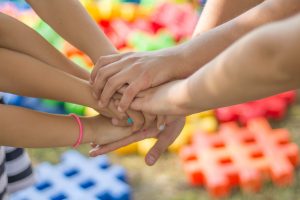Who do you call on when you are facing a problem or need someone to talk to? Conventional wisdom argues that most people first turn to a spouse in their time of need. If one does not have a spouse, or that spouse is unavailable, you are most likely to turn to your parents (and more specifically, your mother). Sons and daughters, and then siblings, round out the order of contact. This follows the Convoy Model, where relationships fall into levels of closeness and that people would go to their closest connections first. One’s spouse, parents, children, and siblings are all common members of the inner circle.
Where would your cousins fit in this scenario? How about your grandparents, grandchildren, aunts, uncles, or stepfamily? Prior research has focused strongly on the nuclear family network, obscuring the relationships with other family members and how these may be enacted in times of need. Extended family often live nearby and play an important role in family members’ lives.
These extended family members may even be a source of resilience in times of crisis by providing practical, financial, or emotional support or alleviating loneliness. Some studies have aimed to count available extended kin or record the interactions with family beyond parents, children, and siblings, but only get as specific as “other relatives,” but little is known about how people rely on these extended family networks for support, particularly in times of great need.
To better understand these relationships, my coauthors (Megan N. Reed, Linda Li, Luca Maria Pesando, Frank F. Furstenberg, and Julien O. Teitler) and I investigated the patterns of extended family communication in the wake of crisis, in this case, the COVID-19 pandemic. We developed a survey module for the Robin Hood Poverty Tracker survey, which began in 2012, and that module was administered in New York City between August 2020 and September 2021, meaning respondents were still experiencing the impact of the COVID-19 pandemic. With a sample of over 2,300 respondents, we analyzed frequency of communication and change in communication by gender, age, education, race/ethnicity, and household composition.
Findings reveal that respondents were frequently in contact with non-residential family members, with more than half (55.7%) stating they communicated several times a week and only 6% communicating less than once a month or not at all. Further, respondents reported increased communication compared to before the COVID-19 pandemic. As the Convoy Model would suggest, the increase in communication was focused on the family members generally thought to be in the inner circle – siblings (31.0%), parents (22.3%), and children (15.6%). However, after those groups, it was not grandparents (4.3%) or grandchildren (4.9%) that were most common for increased communication, but cousins (14.2%), aunts and/or uncles (13.9%), and other relatives (7.1%). It may be that respondents were already in frequent communication with grandparents or grandchildren, or that they did not have these family members to communicate with, but even so, the sizable increase in communication with extended family illustrates how these family members are called upon in times of crisis or uncertainty. We do not just rely on our parents, siblings, and children, but we reach out to extended family networks for support.
Increased communication with family, both nuclear and extended, is expectedly not uniform across demographic groups. We found class (as measured by income and education) correlated with frequency of communication and whether that communication increased. One may expect respondents living in poverty to increase contact with family members in times of need, but respondents living below the poverty line reported less frequent communication with non-residential family. One may expect that it was primarily those living in poverty who would have increased their contact with family members during the pandemic, but we found no difference by poverty status in increased frequency of communication with non-coresidential family. Those with a college degree had higher odds of increasing communication with non-residential family during the pandemic, particularly with siblings, parents/grandparents, and collateral (aunts, uncles, cousins, and other) kin. This supports other findings that this population reported greater concerns over safety during the pandemic. (See the article for analysis and discussion of racial/ethnic differences!)
Past research has mainly focused on the nuclear family, which has long seen to be a source of support, but this study uncovers how family, and even extended family, can serve as a support, particularly in times of need.Future research should recognize how we do not rely only on close family, but that extended family, including cousins, aunts, uncles, and others, play a substantive role in our lives. This may be more so the case in times of great crisis, like the COVID-19 pandemic, and should be studied to understand when and how these networks are enacted, and if frequent communication and support are maintained, decline, or increase after the crisis is over. Further study should investigate forms of support other than communication, including practical and financial, provided by extended family, to better understand the complexity of family networks and functions. Lastly, additional investigation is required to understand the role of education and income on the frequency and increase of extended family contact. The research described here is an important step toward recognizing the role of extended family in a time of crisis, and one of the major contributions is illustrating the need for more research on the subject.
Lauren Harris is an Assistant Professor of Human Development and Family Studies at the University of New Hampshire. Her research focuses on the structures and meanings of family, and the processes associated with developing romantic relationships, currently among older adults. You can learn more about her work here and here, and her take on The Golden Bachelor on twitter @lauren_e_harris.


Comments